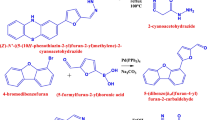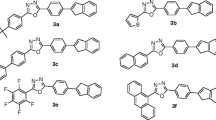Abstract
A series of coumarin dyes having common acceptor and pi spacer with different donors were synthesized and characterized by spectroscopic techniques. The TiO2 nanoparticle has been synthesized by sol-gel method and characterized by X-ray diffraction, scanning electron microscopy and energy dispersive spectroscopy. Photophysical and electrochemical properties have been investigated. The band gap, molar absorption coefficient and energies of frontier molecular orbitals (FMO) have been calculated. The results showed that an electron releasing group helps in tuning the band gap. The geometry optimization and energies of FMO were obtained by density functional theory calculations. The calculated global chemical parameters help in understanding the intrinsic donor-acceptor properties of the synthesized dye molecules. The result of current-voltage characteristics showed good photocurrent response under illumination condition.








Similar content being viewed by others
References
Chan MMY, Tao CH, Yam VWW (2010) In: Yam V (ed) WOLEDs and organic photovoltaics, green energy and technology. Springer, Heidelberg, p 1. https://doi.org/10.1007/978-3-64214935-1_1
Fung DDS, Choy WCH (2013) Introduction to organic solar cells. In: Choy W (ed) Organic solar cells green energy and technology. Springer, London, p 1. https://doi.org/10.1007/978-1-4471-4823-4_1
Hara K, Sayama K, Arakawa H, Ohga Y, Shinpo A, Suga S (2001) A coumarin-derivative dye sensitized nanocrystalline TiO2 solar cell having a high solar-energy conversion efficiency up to 5.6%. Chem Commun 6:569–570. https://doi.org/10.1039/B010058G
Furniss BS, Hannaford AJ, Smith PWG, Tatchell AR (1989) Vogel's textbook of practical organic chemistry. Wiley, New York
Razi SS, Ali R, Srivastava P, Misra A (2014) Simple Michael acceptor type coumarin derived turn-on fluorescence probes to detect cyanide in pure water. Tetrahedron Lett 55:2936. https://doi.org/10.1016/jtetlet201403087
Allen CFH (1930) The identification of carbonyl compounds by use of 2,4-dinitrophenylhydrazine. J Am Chem Soc 52(7):2955–2959. https://doi.org/10.1021/ja01370a058
Wolfrom ML, Arsenault GP (1960) Preparation of 2,4-dinitrophenylhydrazine derivatives of highly oxygenated carbonyl compounds. J Org Chem 25(2):205–208. https://doi.org/10.1021/jo01072a014
Polizzotti A, Berke JS, Falsgraf E, Johal M (2012) In: Fthenakis V (ed) Third generation photovoltaics. InTech, Croatia, p 111
Sugino T, Tanaka K (2001) Solvent-free Coumarin synthesis. Chem Lett 30(2):110–111. https://doi.org/10.1246/cl2001110
Vidyasagar CC, Arthoba Naik Y, Venkatesha TG, Manjunatha P (2012) Sol–gel synthesis using glacial acetic acid and optical properties of anatase Cu–TiO2 nanoparticles. J Nanoeng Nanomanuf 2:91–98. https://doi.org/10.1166/jnan2012.1058
Hara K, Kurashige M, Dan-oh Y, Kasada C, Shinpo A, Suga S, Sayama K, Arakawa H (2003) Design of new coumarin dyes having thiophene moieties for highly efficient organic-dye-sensitized solar cells. New J Chem 27:783–785. https://doi.org/10.1039/B300694H
Yathisha RO, Arthoba Nayaka Y, Manjunatha P, Purushothama HT, Vinay MM, Basavarjappa KV (2019) Study on the effect of Zn2+ doping on optical and electrical properties of CuO nanoparticles. Physica E: Low-dimensional Systems and Nanostructures 108:257–268. https://doi.org/10.1016/j.physe.2018.12.021
Hou J, Guo X (2013) Active layer materials for organic solar cells. In: Choy WCH (ed) Organic solar cells. Springer, London. https://doi.org/10.1007/978-1-4471-4823-4_2
Hara K, Sato T, Katoh R, Furube A, Ohga Y, Shinpo A, Suga S, Sayama K, Sugihara H, Arakawa H (2003) Molecular design of coumarin dyes for efficient dye-sensitized solar cells. J Phys Chem B 107:597–606. https://doi.org/10.1021/jp026963x
Kim B, Ma B, Venkat RD, Liu H, Frechet JMJ (2010) Bodipy-backboned polymers as electron donor in bulk heterojunction solar cells. Chem Commun 46:4148. https://doi.org/10.1039/B927350F
Xu Y, Martin AAS (2000) The absolute energy positions of conduction and valence bands of selected semiconducting minerals. Am Mineral 85:543–556. https://doi.org/10.2138/am-2000-0416
Agrwal S, Pastore M, Marott G, Reddy MA, Chandrashekarm M, Angelis FD (2013) Optical properties and aggregation of phenothiazine-based dye-sensitizers for solar cells applications a combined experimental and computational investigation. J Phys Chem C 117(19):9613–9622. https://doi.org/10.1021/jp4026305
Pearson RG (1997) Chemical hardness. Wiley, Germany, p 38
Mulliken RS (1934) A new Electroaffinity scale: together with data on valence states and on valence ionization potentials and Electron affinities. J Chem Phys 2:782–793. https://doi.org/10.1063/1.1749394
Stanley A, Matthews D (1995) The dark current at the TiO2 electrode of a dye-sensitized TiO2 photovoltaic cell. Aust J Chem 48(7):1293. https://doi.org/10.1071/CH9951293
Acknowledgments
Authors are thankful to UGC-SWRO and Department of Collegiate Education-Bangalore for selecting under UGC-FIP scheme. The authors are also thankful to DST (SERB), New Delhi, UGC New Delhi, for providing the instrumental facility.
Author information
Authors and Affiliations
Corresponding author
Additional information
Publisher’s Note
Springer Nature remains neutral with regard to jurisdictional claims in published maps and institutional affiliations.
Electronic Supplementary Material
ESM 1
(DOCX 959 kb)
Rights and permissions
About this article
Cite this article
Basavarajappa, K.V., Nayaka, Y.A., Yathisha, R.O. et al. Synthesis, Characterization, Optical, Electrochemical and Current-Voltage Characteristics of Coumarin Dyes. J Fluoresc 29, 1201–1211 (2019). https://doi.org/10.1007/s10895-019-02436-7
Received:
Accepted:
Published:
Issue Date:
DOI: https://doi.org/10.1007/s10895-019-02436-7




